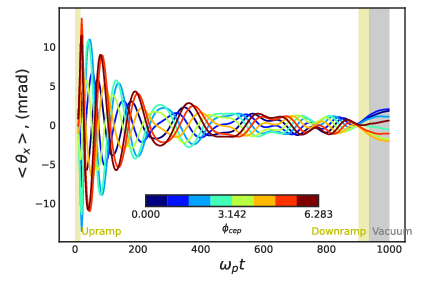ELEMENTARY PARTICLE PHYSICS
Helmholtz Institute Jena Researchers Use JUWELS to Better Understand New Forms of Plasma
Principal Investigator:
Dr. Daniel Seipt
Affiliation:
Helmholtz Institute Jena
Local Project ID:
qedlwfa
HPC Platform used:
Juwels CPU at JSC
Date published:

PIC simulation results for the CEP-dependence of electron beam pointing jitter in the laser polarization direction.
Particle accelerators are among the world’s most effective methods for experiments in materials science and physics. High-intensity, laser-based accelerators are novel accelerator-concepts which are much more compact compared to conventional accelerator facilities. As next-generation facilities with even more powerful lasers begin to come online, researchers must reckon with how these devices can alter plasmas contained in these accelerators through so-called quantum electrodynamic (QED) effects. Researchers predicted how lasers in these facilities would behave, and researchers are now leveraging high-performance computing (HPC) to model these QED effects and compare with experimental data.
In order to ensure that ensure reliable, stable beams in future facilities, researchers at the Helmholtz Institute Jena have turned to the high-performance computing (HPC) power of the JUWELS supercomputer at the Jülich Supercomputing Centre to simulate this process and identify methods for improving beam reliability and stability as these facilities get larger and more powerful.
Using JUWELS, the team was able to identify mechanisms at the particle level that can lead to electron beam pulses “jittering” after its initial pulse in an experiment. By addressing this effect, the researchers hope to improve laser beam stability in future accelerators. The team is preparing a journal article for publication.
For the full report click here